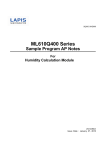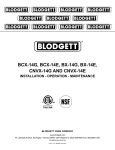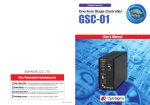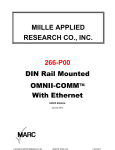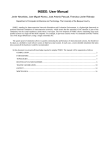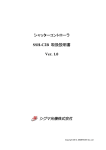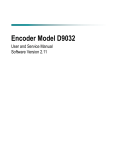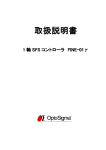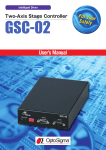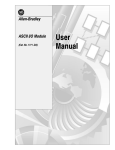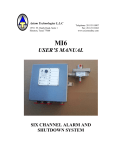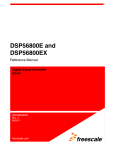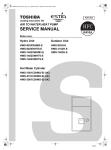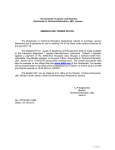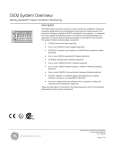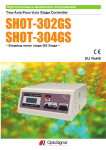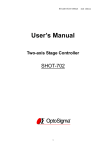Download User`s Manual - OptoSigma Global Top
Transcript
User’s Manual Link controller for multi-axes stages HIT-M / HIT-S 1 Copyright 2014, SIGMAKOKI Co.,Ltd. Notes regarding these materials ・ These materials are intended as a reference to assist our customers in the use of the SIGMAKOKI CO., LTD. Product best suited to the customer’s application; they do not convey any license under any intellectual property rights, or any other rights, belonging to SIGMAKOKI CO., LTD. or a third party. ・ SIGMAKOKI CO., LTD. assumes no responsibility for any damage, or infringement of any third-party’s rights, originating in the use of any product data, diagram, charts, programs, or algorithms contained in these materials. ・ All information contained in these materials, including product data, diagrams, charts, programs and algorithms represents information on products at the time of publication of these materials, and are subject to change by SIGMAKOKI CO.,LTD. without notice due to product improvements or other reasons. ・ When using any or all of the information contained in these materials, including product data, diagrams, charts, programs, and algorithm, please be sure to evaluate all information and products. SIGMAKOKI CO., LTD. assumes no responsibility for any damage, liability or other loss resulting from the information contained herein. ・ SIGMAKOKI CO., LTD. products are not designed or manufactured for use in equipment or system that is used under circumstances in which human life is potentially at stake. SIGMAKOKI CO., LTD. products cannot be used for any specific purposes, such as apparatus or systems for transportation, vehicular, medical, aerospace, nuclear, or undersea repeater use. ・ The prior written approval of SIGMAKOKI CO., LTD. is necessary to reprint or reproduce in whole or in part these materials. ・ If these products or technologies are subject to the Japanese export control restrictions, they must be exported under a license Japanese government and cannot be imported into a country other than the approved destination. Any diversion or re-export contrary to the export control laws and regulations of Japan and/ or the country of destination is prohibited. 2 Copyright 2014, SIGMAKOKI Co.,Ltd. Contents For Your Safety ................................................... 4 Chapter 1: Before You Begin ..................................... 6 1-1.Package Contents ........................................................................................................................................................ 6 2.Overview 1-2. Overview ............................................................................................................................................................................. 6 1-3.HIT3.HIT-M, HITHIT-S System Diagram........................................................................................................................... 7 1-4.Parts and Functions.................................................................................................................................................... 8 Chapter 2: Connection Flow ..................................... 10 2-1.Connection 1.Connection between HITHIT-S and motorized stage ............................................................................... 10 2-2.Interface 2.Interface between HITHIT-M and HITHIT-S........................................................................................................... 10 2-3.Interface with PC....................................................................................................................................................... 11 2-4.Power Supply ................................................................................................................................................................ 11 Chapter 3: Settings ............................................. 12 3-1.Settings Motor Driving Current........................................................................................................................ 12 3-2.Memory Switch settings........................................................................................................................................ 13 3-3.Memory Switch contents list and detailed settings ........................................................................... 13 3-4.LAN settings ................................................................................................................................................................. 27 Chapter 4: Feature .............................................. 28 4-1.HIT mode command command ................................................................................................................................................. 28 4-2.SHOT mode command............................................................................................................................................ 43 4-3.Program functions ..................................................................................................................................................... 55 .Origin 4-4.Origi n Reset Setting ................................................................................................................................................ 58 4-5.Emergency STOP ...................................................................................................................................................... 62 Chapter 5: Rotation Stage ...................................... 63 5-1.HIT mode ......................................................................................................................................................................... 63 5-2.SHOT Mode [Close loop control] ................................................................................................................... 64 Chapter 6: Specifications ...................................... 65 6-1.Specifications ............................................................................................................................................................... 65 6-2.Connector Pin Assignments ............................................................................................................................... 67 6-3.Outlines ............................................................................................................................................................................ 70 3 Copyright 2014, SIGMAKOKI Co.,Ltd. For Your Safety Before using this product, read this manual and all warnings or cautions in the documentation provided. Only Factory Authorized Personnel should be changes and/or adjust the parts of controller. The Symbols Used in This Manual ! WARNING ! CAUTION This symbol marks warnings that should be read This symbol indicates where caution should be used and used to prevent serious injury or death. to avoid possible injury to yourself or others, or damage to property. The above indications are used together with the following symbols to indicate the exact nature of the warning or caution. Examples of Symbols Accompanying Warnings and Cautions △Symbols enclosed in a triangle indicate warnings and cautions. The exact nature of the warning or caution is indicated by the symbol inside (the symbol at left indicates risk of electrocution). ○Symbols enclosed in a circle mark indicate prohibitions(actions that must not be performed).The exact nature of the prohibition is indicates by the symbol inside or next to the circle mark (the symbol at left indicates that the product must not be disassembled). ●Symbols inside a black circle mark actions that must be performed to ensure safety. The exact nature of the action that must be performed is indicated by the symbol inside (the symbol at left is used in cases in which the AC adapter must be unplugged to ensure safety). Symbols on the product The symbol mark on the product calls your attention. Please refer to the manual, in the case that you operate the part of the symbol mark on the product. ! This symbol labeled on the portion calls your attention. 4 Copyright 2014, SIGMAKOKI Co.,Ltd. Disclaimer of Liability ① SIGMAKOKI CO., LTD. does not accept liability for damages resulting from the use of this product or the inability to use this product. ② SIGMAKOKI CO., LTD. does not accept liability for damages resulting from the use of this product that deviates from that described in the manual. ③ SIGMAKOKI CO., LTD. does not accept liability for damages resulting from the use of this product in extraordinary conditions, including fire, earthquakes, and other acts of God, action by any third party, other accidents, and deliberate or accidental misuse. ④ If the equipment is used in a manner not specified by the SIGMAKOKI CO., LTD., the protection provided by the equipment may be impaired. ! WARNING ● Do not use this product in the presence of flammable gas, explosives, or corrosive substances, in areas exposed to high levels of moisture or humidity, in poorly ventilated areas, or near flammable materials. ● Do not connect or check the product while the power is on. ● Installation and connection should be performed only by a qualified technician. ● Do not bend, pull, damage, or modify the power or connecting cables. ● Do not touch the products internal parts. ● Connect the earth terminal to ground. ● Should the product overheat, or should you notice an unusual smell, heat, or unusual noises coming from the product, turn off the power immediately. ● Do not turn on the power in the event that it has received a strong physical shock as the result of a fall or other accident. ● Do not touch the stage while operation. ● Use dry clothes only for cleaning the equipment. 5 Copyright 2014, SIGMAKOKI Co.,Ltd. Chapter 1: Before You Begin 1-1.Package Contents Purchasers of the Stage Controller should find that the package contains the items listed below. Check the package contents using the following checklist. Contact your retailer as soon as possible in the event that you should find that any item is missing or damaged. As HIT-M or HIT-S is selling indivisually, please take care of this point when you purchase. HIT-M set HIT-S set □HIT-M Stage Controller □HIT-S Stage Controller □User’s Manual (This Manual) □LAN Cable (0.6m) Option □PAT-POW (DC24V Power Supply) 1-2.Overview This controller is a Multi-Axes Moterized Stage Controller built in 5 Phase stepping motor Driver (Maximum 8 axes’ connection possible). Since micro-step driver is installed, it is possible to be done with high resolutional operation and positioning. When HIT-M is connected to an ordinary personal computer via an RS232C, USB or LAN interface, the stage can be accurately moved to the desired position by simple commands sent from the PC. 6 Copyright 2014, SIGMAKOKI Co.,Ltd. 1-3.HIT-M, HIT-S System Diagram (*) In case of connection between PC and HIT-H directry please use cross cable, and in case of connection through HUB please use straight cable. 7 Copyright 2014, SIGMAKOKI Co.,Ltd. 1-4.Parts and Functions HIT-M Front Panel 1) 7Seg LED 6) RS232C Connector 2) Emergency STOP Connector 7) USB Connector 3) I/O Connector 8) LINK Connector 4) Power Supply Terminal 5) FG Terminal 9) ETHERNET Connector 1) 7 Segment LED : When Power (DC24V) is supplied, it shows No.of axis connected for approx.4 seconds, then dot in LED box flashes. 2) Emergency Stop Connector : It connects with Emergency Stop Switch. Please refer to「4-5 Emergency STOP」for further details. 3) I/O Connector : It interfaces with input/output signal for external devices. 4) Power Supply Terminal : Supply Power (DC +24V 1A) 5) FG Terminal : It is Terminal for Frame Ground. Please connect to Earth in the actual environment. 6) RS232C Connector : When control by RS232C Interface through PC, please use RS232C. 7) USB Connector : When control by USB Interface trough PC, please use USB. 8) LINK Connector :In case of connection between HIT-M and HIT-S, connect with using attached straight LAN cable. 9) ETHERNET Connector : In case of connection through Ethernet from PC, connect with using straight or cross LAN cable. Make sure to set up and wire the cable supplying DC+24V and FG_GND to the HIT-M so that the maximum length of cable is not longer than 2m. For your own safety, make sure POWER is OFF before connecting every cable. 8 Copyright 2014, SIGMAKOKI Co.,Ltd. HIT-S Front Panel 1) INDICATOR LED 6) RUN Potentiometer 2) No. of Switch 7) STOP Potentiometer 3) END Switch 8) Connector for Stage Driving 4) Scale Connector 9) Power Supply Terminal 5) LINK Connector 10) FG Terminal 1) INDICATOR LED : Shows the HIT-S condition. When it is booted with no fault, LED flashes. In case of fault-booting, LED light is on. : Sets the HIT-S address. Please refer to「2-2 Interface between HIT-M and HIT-S」 2) No.Switch for further details. : Sets the terminating node. Please refer to 「2-2 Interface between HIT-M and 3) END Switch HIT-S」 for further details. 4) Scale Connector : Connects to the cable attached to the Glass Scale in use. 5) LINK Connector : Connects to a straight LAN cable, for connecting HIT-M and HIT-S. 6) RUN Potentiometer : The current delivered when the motor is moving can be set by adjusting RUN potentiometer above. Please refer to 「3-1 settings for motor driving current」 for further details. 7) STOP Potentiometer : The current delivered when the motor is stopped can be set by adjusting STOP potentiometer above. Please refer to 「3-1 settings for motor driving current」 for further details. 8) Connector for Stage Driver 9) Power Supply Terminal 10) FG Terminal : Connects to the cable attached to the motorized stage in use. :DC +24V 1A Power Supply :Frame Ground Terminal. Please connect to EARTH when using. Make sure to set up and wire the cable supplying DC+24V and FG_GND to the HIT-S so that the maximum length of cable is not longer than 2m. 9 Copyright 2014, SIGMAKOKI Co.,Ltd. For your own safety, make sure POWER is OFF before connecting every cable. Chapter 2: Connection Flow 2-1.Connection between HIT-S and motorized stage First, connect HIT-S and every mtorized stage. Here it shows the case that TSDM(GS)60-15X with built in glass scale is connected to HIT-S. ① Connect tne connector (round connector 10p: Female) of TSDM(GS)60-15X with standard cable(DHR-CA) ② Connect the connector of “STAGE” of FRONT Panel with the other side of standard cable (DHR-CA) connected to TSDM(GS)60-15X in No.1 procedure. ③ Connect tne scale connector of TSDM(GS)60-15X with standard cable (GSE-CA) ④ Connect the scale connector of “SCALE” of FRONT Panel with the other side of standard cable (GSE-CA) connected to TSDM(GS)60-15X in No.3 procedure. 2-2.Interface between HIT-M and HIT-S (1) How to connect HIT-M and HIT-S Please connect HIT-M LINK connector and HIT-S LINK connector (address 0) with straight LAN cable. When 2 axes are in need, which means 2 HIT-S are being used, please connect a LINK connector on 1st HIT-S (address 0) and the other LINK connector on 2nd HIT-S (address 1) with straight LAN cable. IN this case, please set the END.Switch on 2nd HIT-S (address 1) ON. (2) No. Switch Up to 8 stages, numbered from 0 to 7, can be controlled by setting address No.s of HIT-S with No.Switch. (3) Terminating node Please set terminating node by switching on END.Switch in HIT-S. *) When a stand (more than two) displays plural HIT-M/HIT-S and installs it, please keep it away more than 20mm to a horizontal direction and vertical directions. More than 20mm More than 20mm 10 Copyright 2014, SIGMAKOKI Co.,Ltd. 2-3.Interface with PC (1) RS232C Connection Please connect by using RS232C (RS232C/STR) cable. In this case, please set the memory switch (Interface) to RS232C. (2) USB Connection Please connect by using USB cable. In this case, please set the memory switch (Interface) to USB. (3) LAN connection Please connect by using LAN crossover cable (LAN-CA). However, please use straight LAN cable when connecting via HUB. Then, set Memory Switch (INTFACE) to Ethrnet. [192.168.0.1] and [255.255.255.0] are set as default value for IP address of HIT-M and Subnet Mask respectively. Please set IP address for PC to [192.168.0.X] (X can be any number from 0 to 255.) and Subnet Mask [255.255.255.0] in order for PC to be able to communicate with HIT-M. With regard to LAN settings for HIT-M, please refer to「3-4 LAN Settings」. 2-4.Power Supply Power supply should be done as instructed below. Use DC24V for both HIT-M and HIT-S. ① First, switch HIT-S on. ② Next, switch HIT-M on. 7 Seg LED on HIT-M will show the No. of axis of HIT-S connected to HIT-M for approx. 4 seconds, and dot in LED will start to flicker. (Please ensure to follow the Power Supply order instructed above, because communication between HIT-M and HIT-S can not be completed when location of terminating node is unsure. *Note) They can also be switched on at the same time. ③ When HIT-M is switched on, “INDICATOR” LED on HIT-S flashes. (”INDICATOR” LED is still lighted when only HIT-S is switched on, or when fault-interface has been made between HIT-M and HIT-S.) Communication between HIT-M and HIT-S can be made when ”INDICATOR” LED flashes. Please switch HIT-M on once again when LED is still lighted. ④ Dot in 7Seg LED on HIT-M flashes in good condition. 11 Copyright 2014, SIGMAKOKI Co.,Ltd. Chapter 3: Settings 3-1.Settings Motor Driving Current Motor driving current on HIT-S should be set in accordance with stage in use. (RUN/STOP) Potentiometer is on the front side of HIT-S. (Please refer to Diagram 3-1.) Drive Current Potentiometer Potentiometer Diagram 3-1:HIT-S front side Driving current settings (RUN current) Driving current can be set with RUN potentiometer. Its factory default is set to 0.75A/Phase. Pot. Scale 0 1 2 3 4 5 6 RUN current (A/Phase) 0 0.17 0.35 0.66 0.75 0.9 1.1 Stopping current settings (STOP current) Electric current when the motor is stopped can be set with STOP potentiometer. STOP current is set as a percentage of the RUN current. Its factory default is set to approx. 50%. *) STOP current is normally set to approx. 50% of RUN current. (Factory default setting) Vol. Gradation 0 1 2 3 4 5 6 STOP Current(%) 0 10 21 35 50 60 68 12 Copyright 2014, SIGMAKOKI Co.,Ltd. 3-2.Memory Switch settings The Memory Switches store the controller settings. When changing Memory Switch settings use the Sample software (HIT Sample), which can be downloaded from http://www.sigma-koki.com. 3-3.Memory Switch contents list and detailed settings 3-3-1 General No Memory Switch contents Setting Range / Select items Default Value 1 Speed SEL 1-4 1 2 Speed 1(S) 1 - 999999999 10000 3 Speed 1(F) 1 - 999999999 100000 4 Speed 1(R) 1 - 1000 200 5 Speed 2(S) 1 - 999999999 30000 6 Speed 2(F) 1 - 999999999 300000 7 Speed 2(R) 1 - 1000 200 8 Speed 3(S) 1 - 999999999 70000 9 Speed 3(F) 1 - 999999999 700000 10 Speed 3(R) 1 - 1000 200 11 Speed 4(S) 1 - 999999999 100000 12 Speed 4(F) 1 - 999999999 1000000 13 Speed 4(R) 1 - 1000 200 14 MODE_SEL SHOT/HIT HIT 15 OUT Level Normal High/Normal Low Normal High 16 LED_ON ON/OFF ON 1) SPEED SEL: Speed selection at Power ON Select the initial setting Speed No. at Power ON. [Setting Range] 1~4 2)~13) Speed 1~4(S)(F)(R): Speed Setting Set 4 kinds of travel stage Speed (minimum S, maximum F, and acceleration/deceleration time R) at Power ON. [Setting Range] S:1~500000 (Unit:pulse/s) [SHOT mode] S:1~999999999 (Unit:0.01µm/s) [HIT mode] F:1~500000 (Unit:pulse/s) [SHOT mode] F:1~999999999 (Unit:0.01µm/s) [HIT mode] R:1~1000 (Unit:ms) [SHOTmode][HITmode] *) Minimum S values should be set smaller than maximum F at Speed Setting. 13 Copyright 2014, SIGMAKOKI Co.,Ltd. 14) MODE_SEL: Operation mode Settting Operation mode is set. [Select Item] SHOT:SHOT mode (Compatible with SHOT-204MS/SHOT-304GS) HIT:HIT mode 15) OUT Level: I/O Output signal logic Setting Select Logic (Voltage level) for I/O output signal. [Select item] Normal High:Hi level (Active low) normally Normal Low:Lo level (Active High) normally 16) LED_ON: Display setting for 7seg LED on HIT-M and for LED display on HIT-S Set ON or OFF for 7seg LED on HIT-M and for LED display on HIT-S. [Select item] ON: Turn ON OFF: Turn OFF *) OFF setting for LED is available only at normal condition. At abnormal condition, LED will be light. 3-3-2 INTERFACE No Memory Switch contents Setting Range / Select items Default value 1 INTERFACE RS232C / USB / Ethrnet RS232C 2 RS232C_FLOW ON / OFF ON 3 Baudrate 4800/9600/19200/38400/57600 38400 1) INTFACE: Setting for communication Interface Set communication method with HOST (PC). [Select items] RS232C: RS232C Interface USB: USB Interface Ethrnet: Ethrnet Interface 2) RS232C_FLOW: Flow control setting on RS232C Specify whether the controller will do flow control in RS232C communication. [Select item] ON: Hardware (RTS/CTS control) OFF:without Flow control 14 Copyright 2014, SIGMAKOKI Co.,Ltd. 3) Baudrate: Baudrate setting Set the data communication speed for the RS232C Interface. [Select item] 4800: 4800bps 9600: 9600bps 19200: 19200bps 38400: 38400bps 57600: 57600bps 3-3-3 Axis No Memory Switch contents Setting range / Select items Default Value 1 Divide0 1/2/4/5/8/10/20/25/40/50/80/100/125/200/250 20 2 Divide1 1/2/4/5/8/10/20/25/40/50/80/100/125/200/250 20 3 Divide2 1/2/4/5/8/10/20/25/40/50/80/100/125/200/250 20 4 Divide3 1/2/4/5/8/10/20/25/40/50/80/100/125/200/250 20 5 Divide4 1/2/4/5/8/10/20/25/40/50/80/100/125/200/250 20 6 Divide5 1/2/4/5/8/10/20/25/40/50/80/100/125/200/250 20 7 Divide6 1/2/4/5/8/10/20/25/40/50/80/100/125/200/250 20 8 Divide7 1/2/4/5/8/10/20/25/40/50/80/100/125/200/250 20 9 Base Rate0 1~1000 20 10 Base Rate1 1~1000 20 11 Base Rate2 1~1000 20 12 Base Rate3 1~1000 20 13 Base Rate4 1~1000 20 14 Base Rate5 1~1000 20 15 Base Rate6 1~1000 20 16 Base Rate7 1~1000 20 17 Move0 POS/NEG POS 18 Move1 POS/NEG POS 19 Move2 POS/NEG POS 20 Move3 POS/NEG POS 21 Move4 POS/NEG POS 22 Move5 POS/NEG POS 23 Move6 POS/NEG POS 24 Move7 POS/NEG POS 25 ORG0 SEL 0~6 1 26 ORG1 SEL 0~6 1 15 Copyright 2014, SIGMAKOKI Co.,Ltd. 27 ORG2 SEL 0~6 1 28 ORG3 SEL 0~6 1 29 ORG4 SEL 0~6 1 30 ORG5 SEL 0~6 1 31 ORG6 SEL 0~6 1 32 ORG7 SEL 0~6 1 33 ORG offset20 0~999999999 0 34 ORG offset21 0~999999999 0 35 ORG offset22 0~999999999 0 36 ORG offset23 0~999999999 0 37 ORG offset24 0~999999999 0 38 ORG offset25 0~999999999 0 39 ORG offset26 0~999999999 0 40 ORG offset27 0~999999999 0 41 EMG Excitation0 On/Off On 42 EMG Excitation1 On/Off On 43 EMG Excitation2 On/Off On 44 EMG Excitation3 On/Off On 45 EMG Excitation4 On/Off On 46 EMG Excitation5 On/Off On 47 EMG Excitation6 On/Off On 48 EMG Excitation7 On/Off On 1~8) Divide0~7: Divide setting Set Divide for each axis. [Select range] 1/2/4/5/8/10/20/25/40/50/80/100/125/200/250 9~16) Base Rate 0~7: Base Rate setting Set the travel distance per 1 full step pulse for each axis. In case of closed loop control at HIT mode or SHOT mode, connrect value must be set. Otherwise, it is not able to position correctly. (Setting Unit: 0.1µm ) [Setting range] 1~1000 (0.1µm~100µm) Reference: Base Rate TSDM & SGSP20 & SGSP-ACT TAMM 10 20 SGSP26 SGSP33 SGSP-YAW 40 120 5 16 Copyright 2014, SIGMAKOKI Co.,Ltd. 17~24) Move 0~7: Travel direction setting 0~7axis Set + travel direction for each axis. [Select item] POS: Positive rotation NEG: Negative rotation 25~32) ORG0~6 SEL: Origin reset method setting Set Origin reset method for each axis. [Select item] 0: Origin reset OFF 1: ORG1 2: ORG2 3: ORG3 4: ORG4 5: ORG5 6: ORG6 *) Regarding each method, please refer to “Origin Rest Method”. 33~40) ORG offset20~27: ORG offset setting Set ORG offset value for each axis (ORG1、ORG5、ORG6) at the ORG reset. [Setting range] 0~999999999 (Unit:0.01µm) *) When Setting range is set [0], ORG offset value is 0.5mm. 41~48) EMG Excitation 0~7: Motor Exitation setting at Emergency STOP. Set Motor Exitation ON or OFF for each axis at at Emergency STOP. [Select item] ON: Exitation ON OFF: Exitation OFF 17 Copyright 2014, SIGMAKOKI Co.,Ltd. Origin Reset Method ① ORG0 Not reset ORGIN position. ② ORG1 (MINI method compatible, however stage moves to ORG offset value) CW (CCW) Sensor ORG reset speed F Detect CW limit sensor ORG reset speed M Move 0.5mm ORG reset speed S Detect CW limit sensor ORG reset speed M Move to offset position ③ ORG2 (MIDDLE method) CW (CCW) Sensor ORG reset speed F Detect CW limit sensor ORG reset speed M Move 0.5mm ORG reset speed S Detect CW limit sensor ORG reset speed F Detect CCW limit sensor ORG reset speed M Move 0.5mm ORG reset speed S Detect CCW limit sensor ORG reset speed M Move to halfway point between CW/CCW sensor LS halfway point 18 Copyright 2014, SIGMAKOKI Co.,Ltd. ④ ORG3 (for 3 sensor use (LS + ORG)) ④-1 In case that ORG sensor is set on the inside of CW(CCW) sensor ORG sensor CW (CCW) Sensor ORG reset speed F Detect ORG sensor ORG reset speed M Move 0.5mm ORG reset speed S Detect ORG sensor ④-2 In case that ORG sensor is set beyond limit SW toward CW direction. ORG sensor CW (CCW) sensor ORG reset speed F Detect CW limit sensor ORG reset speed M Detect ORG sensor ORG reset speed M Move 0.5mm ORG reset speed S Detect ORG sensor Caution1) In case that after detect CW (CCW) sensor, stage move toward CCW direction and then can not detect ORG sensor (in case of no ORG sensor), stage stop at CCW (CW) sensor position. 19 Copyright 2014, SIGMAKOKI Co.,Ltd. ⑤ ORG4 (for 4 sensor (LS+SD+ORG) use.) ⑤-1 In case that NEAR ORG sensor is on the inside of CW(CCW) sensor. NEAR ORG sensor ORG sensor CW (CCW) sensor ORG reset speed F Detect NEAR ORG sensor ORG reset speed S Detect ORG sensor ⑤-2 In case that ORG sensor is beyond NEAR ORG sensor toward CW(CCW) direction. ORG reset speed F NEAR ORG sensor ORG sensor CW (CCW) sensor Detect CW limit sensor ORG reset speed M Detect NEAR ORG sensor ORG reset speed S Detect ORG sensor Caution1) In case that after detect CW (CCW) sensor, stage move toward CCW direction and then can not detect ORG sensor (in case of no ORG sensor), stage stop at CCW (CW) sensor position. Caution 2) In case that after detect NEAR ORG sensor, stage move toward CW direction and then can not detect ORG sensor (in case of no ORG sensor), stage stop at CW (CCW) sensor position. 20 Copyright 2014, SIGMAKOKI Co.,Ltd. ⑥ ORG5 (for 3 sensor use (LS+ORG(Z phase))) ORG sensor (Z phase) CW (CCW) sensor ORG reset speed F Detect CW limit sensor ORG reset speed F Move to offset position ORG reset speed S Detect ORG sensor (Z phase) ⑦ ORG6 (for 3 sensor use (LS+ORG(Z phase))) ORG sensor (Z phase) CW (CCW) sensor ORG reset speed F Detect CW limit sensor ORG reset speed F Move to offset position ORG reset speed S After detect ORG sensor, move to 0.5mm position ORG reset speed S Detect ORG sensor (Z phase) 21 Copyright 2014, SIGMAKOKI Co.,Ltd. 3-3-4 Sensor No Memory Switch Contents Setting Range / Select item Default value 1 L sensor Level0 Normal Open/Normal Close Normal CLOSE 2 L sensor Level1 Normal Open/Normal Close Normal CLOSE 3 L sensor Level2 Normal Open/Normal Close Normal CLOSE 4 L sensor Level3 Normal Open/Normal Close Normal CLOSE 5 L sensor Level4 Normal Open/Normal Close Normal CLOSE 6 L sensor Level5 Normal Open/Normal Close Normal CLOSE 7 L sensor Level6 Normal Open/Normal Close Normal CLOSE 8 L sensor Level7 Normal Open/Normal Close Normal CLOSE 9 O sensor Level0 Normal Open/Normal Close Normal OPEN 10 O sensor Level1 Normal Open/Normal Close Normal OPEN 11 O sensor Level2 Normal Open/Normal Close Normal OPEN 12 O sensor Level3 Normal Open/Normal Close Normal OPEN 13 O sensor Level4 Normal Open/Normal Close Normal OPEN 14 O sensor Level5 Normal Open/Normal Close Normal OPEN 15 O sensor Level6 Normal Open/Normal Close Normal OPEN 16 O sensor Level7 Normal Open/Normal Close Normal OPEN 17 N sensor Level0 Normal Open/Normal Close Normal OPEN 18 N sensor Level1 Normal Open/Normal Close Normal OPEN 19 N sensor Level2 Normal Open/Normal Close Normal OPEN 20 N sensor Level3 Normal Open/Normal Close Normal OPEN 21 N sensor Level4 Normal Open/Normal Close Normal OPEN 22 N sensor Level5 Normal Open/Normal Close Normal OPEN 23 N sensor Level6 Normal Open/Normal Close Normal OPEN 24 N sensor Level7 Normal Open/Normal Close Normal OPEN 1~8) L sensor Level 0~7: Limit sensor input logoc level setting (0~7axis) Select limit sensor detecting level (Input logic level) for each axis [Select item] Normal Open:(Normally switch ON by detecting limit sensor from SW OFF condition) Normal Close:(Normally switch OFF by detecting limit sensor from SW ON condition) 9~16) O sensor Level 0~7: ORG sensor input logic level setting (0~7axis) Select ORG sensor detecting level (Input logic level) for each axis. [Select item] Normal Open:(Normally switch ON by detecting ORG sensor from OFF condition) Normal Close:(Normally switch OFF by detecting ORG sensor from ON condition) 22 Copyright 2014, SIGMAKOKI Co.,Ltd. 17~24) N sensor Level 0~7: NEAR ORG sensor input logic level setting (0~7axis) Select NEAR ORG sensor detecting level (Input logic level) for each axis [Select item] Normal Open:(Normally switch ON by detecting NEAR ORG sensor from OFF condition) Normal Close:(Normally switch OFF by detecting NEAR ORG sensor from ON condition) 3-3-5 Speed No Memory Switch contents Setting Range / Select item Default value 1 Acceleration0 Linear/S Curve S Curve 2 Acceleration1 Linear/S Curve S Curve 3 Acceleration2 Linear/S Curve S Curve 4 Acceleration3 Linear/S Curve S Curve 5 Acceleration4 Linear/S Curve S Curve 6 Acceleration5 Linear/S Curve S Curve 7 Acceleration6 Linear/S Curve S Curve 8 Acceleration7 Linear/S Curve S Curve 9 ORG0 Speed(S) 1~999999999 50000 10 ORG0 Speed(F) 1~999999999 500000 11 ORG0 Speed(R) 1~1000 200 12 ORG1 Speed(S) 1~999999999 50000 13 ORG1 Speed(F) 1~999999999 500000 14 ORG1 Speed(R) 1~1000 200 15 ORG2 Speed(S) 1~999999999 50000 16 ORG2 Speed(F) 1~999999999 500000 17 ORG2 Speed(R) 1~1000 200 18 ORG3 Speed(S) 1~999999999 50000 19 ORG3 Speed(F) 1~999999999 500000 20 ORG3 Speed(R) 1~1000 200 21 ORG4 Speed(S) 1~999999999 50000 22 ORG4 Speed(F) 1~999999999 500000 23 ORG4 Speed(R) 1~1000 200 24 ORG5 Speed(S) 1~999999999 50000 25 ORG5 Speed(F) 1~999999999 500000 26 ORG5 Speed(R) 1~1000 200 27 ORG6 Speed(S) 1~999999999 50000 28 ORG6 Speed(F) 1~999999999 500000 29 ORG6 Speed(R) 1~1000 200 23 Copyright 2014, SIGMAKOKI Co.,Ltd. 30 ORG7 Speed(S) 1~999999999 50000 31 ORG7 Speed(F) 1~999999999 500000 32 ORG7 Speed(R) 1~1000 200 33 ORG0 Speed(M) 1~999999999 250000 34 ORG1 Speed(M) 1~999999999 250000 35 ORG2 Speed(M) 1~999999999 250000 36 ORG3 Speed(M) 1~999999999 250000 37 ORG4 Speed(M) 1~999999999 250000 38 ORG5 Speed(M) 1~999999999 250000 39 ORG6 Speed(M) 1~999999999 250000 40 ORG7 Speed(M) 1~999999999 250000 1~8) Acceleration0~7: Speed –acceleration profile setting Set speed –acceleration profile for each axis [Select item] Linear: Trapezoidal control S Curve: S curve control 9~40) ORG0~7 Speed(S)(F)(R)(M): ORG reset speed setting Set mechanical ORG reset speed (minimum speed S, maximum speed F, acceleration time, medium speed M) for each axis. [Setting Range] S:1~500000 (Unit:pulse/s) [SHOT mode] S:1~999999999(Unit:0.01µm/s) [HIT mode] F:1~500000(Unit:pulse/s) [SHOT mode] F:1~999999999(Unit:0.01µm/s) [HIT mode] R:1~1000(Unit:ms) [SHOT mode] [HIT mode] M:1~999999999(Unit:0.01µm/s) [HIT mode] M:1~500000(Unit:pulse/s) [SHOT mode] *) Regarding Speed setting, minimum speed S should be set smaller than maximum speed F and medium speed M. 24 Copyright 2014, SIGMAKOKI Co.,Ltd. 3-3-6 Close No Memory Switch contents Setting Range / Select item Default value 1 CONT0 Open/Close Open 2 CONT1 Open/Close Open 3 CONT2 Open/Close Open 4 CONT3 Open/Close Open 5 CONT4 Open/Close Open 6 CONT5 Open/Close Open 7 CONT6 Open/Close Open 8 CONT7 Open/Close Open 9 INPOS0 1~99 2 10 INPOS1 1~99 2 11 INPOS2 1~99 2 12 INPOS3 1~99 2 13 INPOS4 1~99 2 14 INPOS5 1~99 2 15 INPOS6 1~99 2 16 INPOS7 1~99 2 17 RES_UNIT0 -30000~30000 100 18 RES_UNIT1 -30000~30000 100 19 RES_UNIT2 -30000~30000 100 20 RES_UNIT3 -30000~30000 100 21 RES_UNIT4 -30000~30000 100 22 RES_UNIT5 -30000~30000 100 23 RES_UNIT6 -30000~30000 100 24 RES_UNIT7 -30000~30000 100 1~8) CONT0~7: Control method setting Set control method (Open Loop control method, Closed Loop control method) for each axis. [Select item] Open:Open Loop control method Close:Closed Loop control method 25 Copyright 2014, SIGMAKOKI Co.,Ltd. 9~16) INPOS 0~7: Inposition range setting In case of Closed Loop setting condition, set Inposition renge (which is the range of stop position at stop completion) for each axis. [Setting range] 1~99 『Point of view about INPOSITION range』 』 In the conition of closed loop control, a positioning of stage is completed when a reading of scale reaches inside a range of INPOS. And Setting value of 1~99 is based on 1 pulse resolution from glass scale. *) Regarding to Scale resolution, it depends on each stage, so please refer to sensor resolution in each stage. <Example> In case of sensor resolution 0.01µm Setting Value=1: INPOS range is 1×±0.01µm=±0.01µm Setting Value=99: INPOS range is 99×±0.01µm=±0.99µm 17~24) RES_UNIT 0~7: Scale setting Set Scale resolution and direction. [Setting Range] -30000~30000: - input is reverse direction. Unit is nm. Reference: Stage RES_UNIT TSDM(GS)60-15(X) -100 TSDM(GS)80-20(X) -100 TSDM(GS)60-10ZF 100 SGSP(GS)26-50(X) -100 SGSP(GS)26-125(X) -100 SGSP(CS)20-85(X) 500 SGSP(CS)26-100(X) 500 SGSP(CS)26-200(X) 500 26 Copyright 2014, SIGMAKOKI Co.,Ltd. 3-4.LAN settings LAN settings for HIT-M ① Connect PC and HIT-M using LAN. Regarding interface between PC and LAN, please refer to「2-3 Interface with PC」. ② Activate HIT Sample. Figure 3-2:Sample software ③ Select LAN as interface from communication settings on menu bar. ④ Open communication settings (Figure 3-3) from menu bar. Settings for HIT-M in use will also be applied to host and port. ⑤ LAN settings (Figure 3-4) will pop up by clicking‘initial settings’ on Communication settings (Figure 3-3). ⑥ Click OK after setting IP address on Figure 3-4 LAN settings in accordance with PC condition. Figure 3-3:Communication settings Figure 3-4:LAN settings *) Redo PC settings according to new LAN settings when any changes have been made in settings. 27 Copyright 2014, SIGMAKOKI Co.,Ltd. Chapter 4: Feature 4-1.HIT mode command 4-1-1 Format of HIT mode command This mode can operate up to 8 axes. General format is shown below. Some formats are different depending on type of command. Please refer to each command explanation for details. code:p0,p1,p2,p3,p4,p5,p6,p7 code Use a string to represent a command. : Command separation(Colon(:)) p0~p7 Use(,)command to separate and assign number of slave unit 0-7. Only integer values can be used as parameter values. A decimal number is an incorrect command and will be responsed by NG. + sign can be abbreviated. +1000 or 1000 is treated as the same command. A travel or distance parameter of 1 is equal to 0.01µm. Parameter is abbreviated when NOP(No Operation) needs to be set to the designated slave unit number. Note: (,)cannot be abbreviated. (Ex) ) ,,p2,p3,p4,p5,,p7 Parameter of slave unit 0 and 1 is abbreviated. p0,,p2,p3,p4,p5,,p7 Parameter of slave unit 1 and 6 is abbreviated. p0,p1 Parameter of slave unit after 2 is abbreviated. Capital or lower case characters can used. Example: h and H are both valid for the Home command. Backspace is effective to delete a prior string. Command string must not have leading or trailing spaces. Otherwise, the command string will not be accepted and NG will be returned as a command error. Immediate movement will be made in case when activation commands such as H, M, A, E, K, and J commands are accepted normally. Unlike the SHOT mode, the activation command (G) is not needed in HIT mode. Activation command (G) is treated as an incorrect command in HIT mode. When issuing Q, ?, !, or I command, its status will be responded. In case which other commands are issued, ‘OK’ or ‘NG’ sign will be responded. ‘OK’ and ‘NG’ signs hereby mean ‘normal acceptance’ and ‘acceptance refused for an incorrect command’ respectively. When other commands except Q, ?, L, !, I, O commands are issued to an engaged slave in busy condition, ‘NG’ sign will be responded for incorrect commands, which will result in the whole command not being executed. When commands are issued to a disconnected slave, the command parameter of disconnected slave will be disregarded, however, commands to the other slaves will be executed normally. 28 Copyright 2014, SIGMAKOKI Co.,Ltd. 4.1.1 Command list Command Movement Detail H Return to mechanical origin M Set number of pulses Detect mechanical origin for relative movement A Set number of Setting of Axis of movement, direction, number of pulses with relative coordinate pulses for Setting of Axis of movement, direction, number of pulses with absolute movement absolute coordinate E Settings of rotary movement Circular interpolation (Move at minimum speed (S)) K Settings of linear interpolation Linear interpolation (Move at minimum speed (S)) movement J Jog command Move by minimum speed (S) L Stop Stop or reduce speed R Set electronic (logical) origin Set the electronic (logical) origin to the current position D Speed settings Set S, F, and R of M and A command C Free motor Excitation ON/OFF S Switch number of steps Switch number of steps (Full step at 0.72°) Q Status1 Return current position etc. ! Status2 Return 1(Busy) or 0 (READY) ? Internal information Return by internal information O I/O output command Output data to OUT terminal of I/O connector I I/O input check Return data to IN terminal of I/O connector P Program control Internal program command B Setting of returning origin Setting of returning origin command (S, F, R and M) speed Z Mode change Switching to SHOT mode or HIT mode Close loop control works when “A” or “M” command is operated and scale is applied to position the stage inside a range of INPOS. During operation of close loop control, a return of position information by Q command is a scale number. 29 Copyright 2014, SIGMAKOKI Co.,Ltd. 4-1-2 H command (Return to mechanical origin command) (1) Function This command indicates detect the mechanical origin for a stage and set the position as the origin. Coordinate value is cleared by 0. When the designated slave number with parameter is 1, the mechanical origin will be operated. No operation to 0 or abbreviated slave unit. (2) Example H:1,1,0 means to operate the mechanical origin to slave number 0 and 1 4-1-3 M command (Relative movementl command) (1) Function This command indicates relative movement with pulse number. Travel is a length and indicates by (0.01µm unit) *) Controller enables to output number of pulse (-134217728 to +134217727). In case of the over number, NG will be returned and stage will not move. (Note: The above limitation is conflicted when a high microstep is set.) When close loop is set, a positioning is completed when a reading of scale reaches inside a range of INPOS. (2) Example M:,100000,-20000,,30000 means to move from current position 1mm, -0.2mm and 0.3mm to slave number 1, 2 and 4 respectively. 4-1-4 A command (Absolute movement command) (1) Function This command indicates Relative movement with pulse number. Travel is a length and indicates by (0.01µm unit) *) Controller enables to output number of pulse (-134217728 to +134217727). In case of the over number, NG will be returned and stage will not move. Actual length of travel is calculated automatically by controller from a specified absolute movement length value. (Note: The above limitation is conflicted when a high microstep is set.) In the conition of closed loop control, a positioning of stage is completed when a reading of scale reaches inside a range of INPOS. (2) Example A:, 0,-20000,,30000 means to return to origin (0), -0.2mm and 0.3mm of absolute position to slave number 1, 2 and 4 respectively. 30 Copyright 2014, SIGMAKOKI Co.,Ltd. 4-1-5 E command (Arc interpolation movement command) (1) Function This command for arc interpolation movement enables to specify operation axis and rotation direction. 3 different modes of parameter are available to operate the arc interpolation movement with arbitrary 2 axes. When this command is sent under condition of busy and unconnected of slave unit, it will be responsed by NG as a command error and all command will stop to operate. To operate an interpolation with this command, a designation of (S shape drive / trapezoidal shape drive) and pulse speed and travel per pulse must be identical for both axes. Otherwise, an interpolation movement will be unable to operate due to an incorrect setting. Note: if there is a difference in Base rate between slave units, apparent speed ( [S, F, R value] and [Microstep] and [Acceleration and Deceleration] pattern (Trapezoidal shape or S shape)) is same, pulse speed and travel per pulse are different. However the speed when operates the arc interpolation movement is minimum speed (S). Coordinate of arc movement is specified based on the relative travel from current position (0.01µm unit). E: :0 command (Arc interpolation movement command 0) is a setting for the end of Coordinate. In order to move out from a circular line as shown by the image right hand side, the end movement of one axis when it reaches to a specified position in a quadrant and stop the interpolation function. Then, another axis move to reach the end point. Note: the specified end point as ended coordinate of arc interpolation inside the area of diagonal line, the stage will move non-stop and arc interpolation movement is effective without end. Due to operation by calculation, there is a calculation error to the ended point of E: : 1 command (Arc interpolation movement command 1) and E: :2command (Arc interpolation movement command 2). Please check the actual stage. 31 Copyright 2014, SIGMAKOKI Co.,Ltd. 4-1-5-1 E:0 command (Arc interpolation movement ommand0 0) (1) Function This command indicates a designation of ended point and center point in order to operate the arc movement. (2) Example E: :0,axis0,axis1,d,e0,e1,c0,c1 axis0, axis1: :0~ ~7 means to designate the number of slave unit to operate arc interpolation movement. Same number of slave unit or unconnect is prohibited. Axis 0 represents X axis andaxis 1 represents Y axis. d: :0 or 1 0 is CW rotation (Clockwise), 1 is CCW rotation (Counterclockwise) e: :Ended point coordinate (e0 axis0 setting value、e1 axis1 setting value) (unit of setting 0.01µm unit) c: :Center point coordinate (c0 axis0 setting value、c1 axis1 setting value) (unit of setting 0.01µm unit) E: :0,2,5,0,0,0,5000,-5000 A center point coordinate is based on a relative coordinate of the current position (0.05mm,-0.05mm) and move stages of slave unit No2, Slave unit No5 one round clockwise until the current position. Axis 5 Axis 2 0.05mm -0.05mm 32 Copyright 2014, SIGMAKOKI Co.,Ltd. 4-1-5-2 E: :1 command (Arc interpolation movement command 1) (1) Function This command indicates a designation of center point and degree of ended point in order to operate the arc movement (2) Example E: :1, axis0,axis1,d,c0,c1,ae axis0, axis1: :0~ ~7 means to designate the number of slave unit to operate arc interpolation movement. Same number of slave unit or unconnect is prohibited. Axis 0 represents X axis and axis 1 represents Y axis. d: :0 or 1 0 is CW rotation(Clockwise). 1 is CCW rotation (Counterclockwise). c: :Center point coordinate (c0 axis0 setting value、c1 axis1 setting value) (unit of setting 0.01µm unit) ae: :Degree of ended point (deg) (Setting range:integer of 0°<ae≦360° The other degree than mentioned is NG.) E: :1,6,7,0,5000,-5000,90 A center point coordinate is based on a relative coordinate of the current position (0.05mm,-0.05mm) and move stages of slave unit No6、Slave unit No7 90°from current position to degree of ended point position clockwise. Axis 7 0.05mm Axis 6 90° -0.05mm 33 Copyright 2014, SIGMAKOKI Co.,Ltd. 4-1-5-3 E: :2 command (Arc interpolation movement command 2) (1) Function This command indicates a designation of pass point coordinate and ended point’s coordinate in order to opearate the arc interpolation movement. Note: if 3 points (current position, pass point coordinate and ended point coordinate) lay on the same straight line, it is unable to make an arc movement. (2) Example E: :2, axis0,axis1,p0,p1,e0,e1 axis0, axis1: :0~ ~7 means to designate the number of slave unit to operate arc interpolation movement. Same number of slave unit or unconnect is prohibited. Axis 1 represents X axis and axis 2 represents Y axis. p: :Pass point coordinate (p0 axis0 setting value、p1 axis1 setting value) (unit of setting 0.01µm unit) e: :Ended point coordinate (e0 axis1 setting value、e1 axis1 setting value) (unit of setting 0.01µm unit) E: :2,2,7,5000,3000,8000,12000 Pass point coordinate and ended point coordinate are based on a relative coordinate of the current position (+0.05mm, +0.03mm) and (+0.08mm, +0.12mm). Then, stages of slave unit No2、Slave unit No5 move circularly. Axis 7 0.12mm 0.03mm Axis 2 0.05mm 0.08mm 34 Copyright 2014, SIGMAKOKI Co.,Ltd. 4-1-6 K command (Linear interpolation movement command) (1) Function This command indicates a designation of axis of movement and a designation of relative movement in order to operate linear interpolation movement. Operation of linear interpolation movement is able to designate up to arbitrary 3 axes. When this command is sent under condition of busy and unconnected of slave unit, it will be responsed by NG as a command error and all command will stop to operate. To operate an interpolation with this command, a designation of (S shape drive / trapezoidal shape drive) and pulse speed and travel per pulse must be identical for both axes. Otherwise, an interpolation movement will be unable to operate due to an incorrect setting. Note: if there is a difference in Base rate between slave units, apparent speed ( [S, F, R value] and [Microstep] and [Acceleration and Deceleration pattern (Trapezoidal shape or S shape)) is same, pulse speed and travel per pulse are different. Coordinate of linear movement is specified based on the relative travel from current position (0.01µm unit). (2) Example K: :axis0,axis1, axis2,e0,e1,e2 axis0,axis1,axis2: :0~ ~7 means to designate the number of slave unit to operate linear interpolation movement. Same number of slave unit or unconnect is prohibited. To operate linear interpolation movement by 2 axes, please abbreviate axis2. e:Ended point coordinate (e0 axis0 setting value、e1 axis1 setting value、e2 axis2 setting value) To operate linear interpolation movement by 2 axes, please abbreviate axis2. (unit of setting 0.01µm unit) K: :1,4,,+10000,20000 Ended point coordinate is based on a relative coordinate of the current position (+0.1mm, +0.2mm) and move stages of slave unit No1、Slave unit 4 axis No4 linearly. 0.2mm 1 axis 0.1mm 35 Copyright 2014, SIGMAKOKI Co.,Ltd. 4-1-7 J command (Jog command) (1) Function This command indicates to drives stages continuously (at a constant speed) at the minimum pulse speed (S). During command operation, stage will move non-stop until the detection of limit sensor or receipt of Stop command (L command). (2) Example J: :s0,s1,s2,s3,s4,s5,s6,s7 s: :+,- or abbreviated + is + direction, - is - direction、abbreviated is NOP(No Operation). J: :,+,,,,-,+,- Jog movement to Slave unit No1 is + direction, Slave unit No5 is - direction, Slave unit No6 is + direction, Slave unit No7 is - direction. No movement to Slave unit No0、2-4. 4-1-8 L command (Decelerate and stop command) (1) Function Deceleration and stop stage (2) Example L: :p0,p1,p2,p3,p4,p5,p6,p7 p: :0,1 or abbreviated 1 is to decelerate and stop stage of the slave unit number. 0 or abbreviated are NOP(No Operation). L: :,,1,1 4-1-9 L:E command To decelerate and stop stage of the slave unit No2 and 3. (Emergency stop (Immediate stop) command) (1) Function This command indicates to stop stages of all slave units immediately. (2) Example L: :E means to stop stages of all slave units immediately. 36 Copyright 2014, SIGMAKOKI Co.,Ltd. 4-1-10 R command (Return to logical origin command) (1) Function This command indicates a setting of logical origin (coordinate value 0) to the stage of the designated slave unit number based on the current position. When this command is sent under condition of busy and unconnected of slave unit, it will be responsed by NG as a command error and all command will stop to operate. (2) Example R: :p0,p1,p2,p3,p4,p5,p6,p7 p: :0,1 or abbreviated 1 is to set the logical origin to the stage of the slave unit number. 0 or abbreviated are NOP(No Operation) means to set the logical origin (coordinate value 0) to the stage of the R: :,,1,1 slave unit number 2 and 3. 4-1-11 D command (Speed setting command) (1) Function This command indicates a speed setting to the designated slave unit number. It is unable to set the multiple number of slave unit at the same time. When this command is sent under busy condition of slave unit, it will be responsed by NG as a command error and all command will stop to operate. (2) Example D: :axis,s,f,r axis: : Slave unit number s: : Start-up speed (Initial speed) range of setting: 1~999999999 (unit : 0.01µm/s) f: : Maximum speed range of setting: 1~999999999 (unit : 0.01µm/s) r: : Acceleration / deceleration time 0~7 range of setting:1~1000 (unit : ms) Note : the condition of s<=f *) Maximum speed (calculated by pulse) is 800000(pulse/s). In case of over speed setting (travel: 0.01µm/s unit), OK will be returned, but it will be treated as speed of 800000(pulse/s). D: :5,10000,100000,200 means Start-up speed : 0.1mm/s, 1mm/s : Maximum speed, 200ms : Acceleration / deceleration time to slave unit No5. 37 Copyright 2014, SIGMAKOKI Co.,Ltd. 4-1-12 C command (Excitation On/OFF command) (1) Function This command indicates an Excitation On/OFF of motor. The stage is able to move (rotate) manually when the excitation OFF of motor. When this command is sent under busy condition of slave unit, it will be responsed by NG as a command error and all command will stop to operate. (2) Example C: :p0,p1,p2,p3,p4,p5,p6,p7 p: :0,1 or abbreviated 1 is an Excitation ON to the stage of the slave unit number. 0 is an Excitation OFF to the stage of the slave unit number. The abbreviation is NOP(No Operation) C: :,,1,0 Excitation ON to the motor of the slave unit No2, and OFF to motor of slave unit No3. 4-1-13 S command (Setting microstep command) (1) Function This command indicates to change motor step angle (microstep). The number of microstep can be set by 15 types. Other numbers except mentioned below cannot be set. 1, 2, 4, 5, 8, 10, 20, 25, 40, 50, 80, 100, 125, 200, 250 Division 1 2 4 5 8 10 20 25 40 50 80 100 125 200 250 Step angle 0.72 0.36 0.18 0.144 0.09 0.072 0.036 0.0288 0.018 0.0144 0.009 0.0072 0.00576 0.0036 0.00288 Pulse 500 1000 2000 2500 4000 5000 10000 12500 20000 25000 40000 50000 62500 100000 125000 2 1 0.5 0.4 0.25 0.2 0.1 0.08 0.05 0.04 0.025 0.02 0.016 0.01 0.008 number per 1 rotation Resolution (µm) When this command is sent under busy condition of slave unit, it will be responsed by NG as a command error and all command will stop to operate. ※) At Closed Loop control method, similar other than Original position, and do not carry out S command. When similar other than Original position and change motor step angle, because a coordinate position changes, work definitely and not carried out. (2) Example S: :d0,d1,d2,d3,d4,d5,d6,d7 d: means to input the command with the above 15 types of number or abbreviation to set the number of step angle to the designated slave unit number. 38 Copyright 2014, SIGMAKOKI Co.,Ltd. The abbreviation is NOP(No Operation). S: :20, 40 Setting Division of 20 and 40 to Slave No0,1. 4-1-14 Q command (Reading current position command) (1) Function This command indicates to return the current position information of 8 stages of slave. unit No 0-7 (0.01µm unit). The returned current position data is separated by (,) -mark represents when the current position is minus. Maximum 10 digit including marking by left-align display. (2) Example Q: : -1000,1000,100,,,,0,0 Return data : current position of slave unit No0 is -0.01mm, 0.01mm to slave unit No1, 0.001mm to slave unit No2, no connection for slave unit No3-5, and 0mm to slave unit No6-7. 4-1-15 Q command (Reading status command) (1) Function This command indicates to return the status information of master and slave unit No0-7. The returned data is separated by (,). The status of the unconnected of slave unit No is abbreviated and display only (,). (2) Example Q: :S stm,sts0,sts1,sts2,sts3,sts4,sts5,sts6,sts7 stm 00: Master accepted the received command. 01: Master rejected the received command due to wrong command. Sts 00~FF: Return the status of the slave unit No with hexadecimal number and 2 digit. Each bit of Hexadecimal number and status are shown as table below. A bit represented by 0 means undetected and 1 means detected. 7 6 5 4 3 2 1 0 - DRV alarm Scale alarm Z limit Near ORG +LS -LS - 0 or 1 0 or 1 0 or 1 0 or 1 0 or 1 0 or 1 0 or 1 Example of returned data 00,01,02,,,,,,01 means master accepted the received command. Detect –LS by Slave unit No0 and 7, detect +LS by Slave unit No1 and Unconnected status by slave unit No2-6. 39 Copyright 2014, SIGMAKOKI Co.,Ltd. 4-1-16 ! command (Reading status command) (1) Function This command indicates to return the status (Busy/Ready) of each slave unit. (2) Example !: sts0, sts1, sts2 ,sts3, sts4, sts5, sts6, sts7 sts Returned data 0 means the ready status of the slave unit. 1 represents the busy status of the slave unit. Abbreviation represents unconnected. Example of returned data 1,0,,,,,,0 means the ready status of slave unit No1 and 7, Busy status of slave unit No0 and unconnected status of slave unit No2 and 6. 4-1-17 ? command (Reading internal information command) ) (1) Feature This command indicates to return controller information. (2) Example ?: :Paxis P above represents by string parameter is shown as table below. axis above represents slave unit number. Note: slave unit No0-7 must be written only when D or B string parameter is applied. String parameter Returned data Example of returned data N Device name HIT-M V Version V1.00-001 Z Mode 0 (SHOT_MODE) 1 (HIT_MODE) P Travel per pulse (µm) 1.00,2.00,1.00,2.00,,,, S Microstep 2,2,20,10,,,, D Travel speed 1000,500000,100 B Returning origin speed 1000,500000,100,200000 L Status of program operation ProgNo、ProgRun、LineNo、Count of remaining Loop (Example)2,1,13,4 13 row of program No.2 is running and count of remaining Loop is 4. 40 Copyright 2014, SIGMAKOKI Co.,Ltd. (Output data command) ) 4-1-18 O command (1) Function This command indicates output the data to the output terminal of I/O connector (4 bit). Output 0 1 2 3 4 5 6 7 8 9 10 11 12 13 14 15 OUT1 OFF ON OFF ON OFF ON OFF ON OFF ON OFF ON OFF ON OFF ON OUT2 OFF OFF ON ON OFF OFF ON ON OFF OFF ON ON OFF OFF ON ON OUT3 OFF OFF OFF OFF ON ON ON ON OFF OFF OFF OFF ON ON ON ON OUT4 OFF OFF OFF OFF OFF OFF OFF OFF ON ON ON ON ON ON ON ON (2) Example O:14 4-1-19 I command (Input data command) ) (1) Function This command indicates iput the data to the input terminal of I/O connector (4 bit). Data 0 1 2 3 4 5 6 7 8 9 10 11 12 13 14 15 IN1 OFF ON OFF ON OFF ON OFF ON OFF ON OFF ON OFF ON OFF ON IN2 OFF OFF ON ON OFF OFF ON ON OFF OFF ON ON OFF OFF ON ON IN3 OFF OFF OFF OFF ON ON ON ON OFF OFF OFF OFF ON ON ON ON IN4 OFF OFF OFF OFF OFF OFF OFF OFF ON ON ON ON ON ON ON ON (2) Example I: : Returned data 4-1-20 P command 14 (Internal program control command) ) (1) Function This command indicates program number selection of internal program and Operate/Stop. Please refer to the detail of program feature from “4-3 program feature”. (2) Example P: :p p: :P, S, E, U0, U1 P: :Pn n represents program number which can be selected 0-9. The others than mentioned will be responsed by NG as a command error. It is 0 when power on. (Example) P:P2 S: : Program No.2 is selected. Start operation of the program. Start operation of the selecting program. (Example) P: :S E: : Finish program operation. When the finish command is accepted, it will finish the under operating in the current Line No.( (Example) )P: :E U0: : Stop program temporarily. When the the command is accepted, it will temporarily stop after the under operating program in the current Line No. 41 Copyright 2014, SIGMAKOKI Co.,Ltd. (Example)P: :U0 U1: : Restart program. The temporary stop of program can be restarted by P: U0. (Example)P:U1 4-1-21 B command (Setting of returning origin speed command) (1) Function This command indicates the setting of returning origin speed to the designated slave unit number. It is unable to set the multiple number of slave unit at the same time. When this command is sent under condition of busy and unconnected of slave unit, it will be responsed by NG as a command error and all command will stop to operate. (2) Example B: :axis,s,f,r,m axis: : Slave unit No.0~7 s: : Start-up speed (Initial speed) range of setting: 1-999999999 (unit : 0.01µm/s) f: : Maximum speed range of setting: 1-999999999 (unit : 0.01µm/s) r: : Acceleration/deceleration time range of setting:1-1000 (unit : ms) m: : Intermediate speed range of setting: 1-999999999 (unit : 0.01µm/s) Note : the condition of s≦m≦f *) Maximum speed (calculated by pulse) is 800000(pulse/s). In case of over speed setting (travel: 0.01µm/s unit), OK will be returned, but it will be treated as speed of 800000(pulse/s). B:5,10000,100000,200,50000 Setting start-up speed by 0.1mm/s, Maximum speed by 1mm/s, Acceleration/deceleration time by 200m and Intermediate speed by 0.5mm/s to slave unit No5. 4-1-22 Z command (Mode change command) (1) Function This command indicates the change of mode (HIT mode or SHOT mode). There are significant different in command format and parameter meaning (travel/pulse) between HIT mode and SHOT mode. Do not change the mode during under program operation. The change of mode must be done after setting the initial value. (2) Example Z: :p p: : Z: :0 0 represents SHOT mode and 1 represents HIT mode. Changed to SHOT mode 42 Copyright 2014, SIGMAKOKI Co.,Ltd. 4-2.SHOT mode command 4-2-1 Format of SHOT mode command This mode follows a specific pattern of SIGMA-KOKI SHOT controller for 5 phase motor stage. Therefor, there are not available to use more than 4 axes stages in this mode. Followings are the general format. But, please refer each command details as there may be a little different point in some commands. code:axis±Pnum±Pnum±Pnum±Pnum +/- Pnum is able to specify and set from 1 to 4. In case of multipul axes, this should be set W. +/- Pnum is applied 1 to 4 (Slave number is 0 to 4) in order from the left. code : Use a string to represent a command. Command separation(Colon(:)) Axis 1 to 4 (Slave number is 0 to 4) or W (In case of multiple number setting) In SHOT mode, please note that the axis number is one more than the slave number as above. ± Specify the movement direction P delimiter letter to moveing distance num Spexcify the moving distance by puls numbers. However, in case of M and A commands in closed loop it is specified the distance asmicrons. This value should not be decimal. If it is decimal, it will be returned NG due to devious command. Capital or lower case characters can used. Example: h and H are both valid for the Home command. Backspace is available to delete one character adjacent. Command string must not have leading or trailing spaces. Otherwise, the command string will not be accepted and NG will be returned as a command error. If commands which are Q, ?, !, I are issued, correspondent status will be retured. In case of other commands, it will be returned OK (correct acceptance) or NG (Reject cceptance due to devious commands) In case of command use like drive commands which are M, A, E, K and J except H, it needs to be activate command (G). 43 Copyright 2014, SIGMAKOKI Co.,Ltd. 4-2-1 Command list Command Movement H Return to mechanical origin Detect mechanical origin M Set number of pulses for Setting of Axis of movement, direction, number of pulses with relative movement relative coordinate Set number of pulses for Setting of Axis of movement, direction, number of pulses with absolute movement absolute coordinate A E Settings Detail of rotary Circular interpolation (Move at minimum speed (S)) of linear Linear interpolation(Move at minimum speed (S)) movement K Settings interpolation movement J Jog command G Execute Move by minimum speed (S) command for Start to move moving L Stop R Set Stop or reduce speed electronic (logical) Set the electronic (logical) origin to the current position origin D Speed settings Set S, F, and R of M and A command C Free motor Excitation ON/OFF S Switch number of steps Switch number of steps (Full step at 0.72°) Q Status1 Return current position etc. ! Status2 Return 1(Busy) or 0 (READY) ? Internal information Return by internal information O I/O output command Output data to OUT terminal of I/O connector I I/O input check Return data to IN terminal of I/O connector P Program control Internal program command B Setting of returning origin Setting of returning origin command (S, F, R and M) speed Z Mode change Switching to SHOT mode or HIT mode Close loop control works when “A” or “M” command is operated and scale is applied to position the stage inside a range of INPOS. During operation of close loop control, a return of position information by Q command is a scale number. If command in busy condition except Q、?、L、!、I、Q command is issued, it return NG as malformed command and not execute the command. If the command is issued to unconnected slave, command parameter of unconnected slave is ignored and command parameter to the other slave will execute normally. 44 Copyright 2014, SIGMAKOKI Co.,Ltd. 4-2-2 H command (Return to mechanical origin) (1) Function Detect mechanical origin and set the position Origin. The coordinate value will be cleared. (2) Example H:1 Detect the mechanical origin for the first axis (Slave No.0). H:4 Detect the mechanical origin for the second axis (Slave No.3). H:W Detect the mechanical origin for the first to 4th axis (Slave No.0 to 3). 4-2-3 M command: Set number of pulses for relative travel (1) Function This command is to specify the axis of travel, direction, and the travel (number of pulses). This command must always be followed by a drive (G) command. Travel is by means of acceleration/deceleration driving. The distance traveled is specified in pulses. OPEN and CLOSED LOOP is able to be specified by each axis. In case of closed loop control, positioning is completed within the range of INPOS after reading scale. (2) Example M:1-P100 Travel 100 pulses in the - direction on the first axis (In open) G: Travel 1000 microns in the - direction on the first axis (In closed loop) M:4-P100 Travel 100 pulses in the - direction on the 4th axis(Slave No.3) (In open) G: Travel 100 microns in the - direction on the 4th axis(Slave No.3) (In closed M:W+P100-P50+ Travel 100 pulses in the + direction on the 1st axis, 50 pulses in the –direction on the P150-P200 2nd, 150 pulses in the + direction on the 3rd axis and 200 pulses in the - direction on G: the 4th axis. (In open) loop) Travel 100 microns in the + direction on the 1st axis, 50 microns in the –direction on the 2nd, 150 microns in the + direction on the 3rd axis and 200 microns in the direction on the 4th axis. (In closed loop) M:W+P100-P50+ Travel 100 pulses in the + direction on the 1st axis, 50 pulses in the –direction on the P0-P200 2nd, not move on the 3rd axis and 200 pulses in the - direction on the 4th axis. (In G: open) Travel 100 microns in the + direction on the 1st axis, 50 microns in the –direction on the 2nd, not move on the 3rd axis and 200 microns in the - direction on the 4th axis. (In closed loop) 45 Copyright 2014, SIGMAKOKI Co.,Ltd. 4-2-4 A command (Absolute movement command) (1) Function This command is to specify the axis of travel, direction, and the travel distance (number of pulses). This command must always be followed by a drive (G) command. Travel is by means of acceleration/deceleration driving. The distance travel is specified in pulses in Open and in micron in Closed loop. Open and Closed loop is able to be specified by each axis. In case of closed loop control, positioning is completed within the range of INPOS after reading scale. (2) Example A:1-P100 Travel 100 pulses in the -direction on the first axis (In open) G: Travel 100 micron in the -direction on the first axis (In closed loop) A:4-P100 Travel 100 pulses in the - direction on the 4th axis(Slave No.3) (In open) G: Travel 100 microns in the - direction on the 4th axis(Slave No.3) (In closed loop) A:W+P100-P50+P150-P200 Travel 100 pulses in the + direction on the 1st axis, 50 pulses in the G: –direction on the 2nd, 150 pulses in the + direction on the 3rd axis and 200 pulses in the - direction on the 4th axis. (In open) Travel 100 microns in the + direction on the 1st axis, 50 microns in the –direction on the 2nd, 150 microns in the + direction on the 3rd axis and 200 microns in the - direction on the 4th axis. (In closed loop) A:W+P100-P50+P0-P200 Travel 100 pulses in the + direction on the 1st axis, 50 pulses in the G: –direction on the 2nd, move to electrical (logical) ORIGIN on the 3rd axis and 200 pulses in the - direction on the 4th axis. (In open) Travel 100 microns in the + direction on the 1st axis, 50 microns in the –direction on the 2nd, move to electrical (logical) ORIGIN on the 3rd axis and 200 microns in the - direction on the 4th axis. (In closed loop) 4-2-5 E Command (Arc interpolation movement command) ) (1) Function Set final / central coordinates for execution of arc interpolation to relative coordinates (pulse rate) against current position. Activation command (G:) is necessary after execution of this command. Rotation is made clockwise at all times. The axis which executes arc interpolation is available in setting only between axis 1(slave no.0) and axis 2 (slave no.1) and not applicable to the alterations. The speed of axis 1 & 2( (S,F,R) ), travel per pulse and acceleration / deceleration speed formula (between trapezoidal shape and S shape) need to be set to same values on two different axes. 46 Copyright 2014, SIGMAKOKI Co.,Ltd. However, travel speed is set to speed S for arc interpolation. (2) Example E:W+P0+P0+P5000+P0 Travel clockwise like drawing a circle against the relative center G: of 5000 pulse position on the first axis as X and the 0 pulse Final coordinates Central coordinates position on the second axis as Y, and then stop at the current position. Final coordinates are to be assigned in command E. However, in case when the circular arc is dislocated as shown in the right figure, interpolation operation terminates at the position where the other axis reaches final position with final quadrant, then it travels to final coordinates. Please note that it cannot be terminated and the operation will continue permanently., when diagonal line in the right figure has been set to final coordinates of arc interpolation, 4-2-6 K Command (Linear interpolation command) ) (1) Function Set final coordinates for execution of linear interpolation to relative coordinates (pulse rate) against current position. Activation command (G:) is necessary after execution of this command. The axis which executes linear interpolation is available in setting only between axis 1(slave no.0) and axis 2 (slave no.1) and not applicable to the alterations. Due to the fact that activation will be processed with speed, the speed of axis 1&2 (S,F,R) ), travel per pulse and acceleration / deceleration speed formula (between trapezoidal shape and S shape) need to be set to same values on 2 different axes. (2) Example E:W+P1000+P500 Travel using linear interpolation to the 1000 pulse position on the first axis G: and the 500 pulse position on the second axis. Final coordinates 47 4-2-7 J Command (Jog movement command) ) (1) Function This command is to continue the movement with start-up speed (S speed). Activation command (G:) is necessary after execution of this command. (2) Example J:1+ Travel axis 1 toward ‘+’ direction with S speed. G: J:4- Travel axis 4 toward ‘-’ direction with S speed. G: J:W+--+ Travel axis 1 toward ‘+’direction, 2 toward ‘-’, 3 toward ‘-’, and 4 toward ‘+’, G: with S speed. 4-2-8 G Command (Activation command) ) (1) Function After the M, A, E, K and J commands, G command is needed to activate the stage . 4-2-9 R Command (Electrical (logical) origin settings command) ) (1) Function Clear the coordinate value by setting current position of the stage to coordinate origin. (2) Example R:1 Set current position on axis 1 to coordinate origin. R:4 Set current position on axis 4 to coordinate origin. R:W Set current position on axis 1 to 4 to coordinate origin. 4-2-10 L Command (Deceleration stop command) ) (1) Function It decelerates and terminates designated axis (stage). (2) Example L:1 Decelerate axis 1 until it terminates. L:4 Decelerate axis 4 until it terminates. L:W Decelerate axis 1 to 4 until they terminate. 48 4-2-11 L:E Command (Emergency stop command) ) (1) Function It terminates designated axis (stage) immediately. (2) Example L:E Stop axis 1 to 4 immediately. 4-2-12 D command (Speed setting command) ) (1) Function When power is on, start-up speed (S), final speed (F) and acceleration and deceleration time (R) of speed number designated by SPEED SEL in memory switch are set within axis 1 to 4 (slave no. 0 to 3). The travel speed can be altered according to this command. Setting range Start-up speed (S) 1~500000pps Final speed (F) 1~500000pps Acceleration and deceleration time (R) 1~1000ms S should be equal to F or smaller. (2) Example D:1S100F1000R200 Set travel speed of axis 1(slave No.0) to S=100pps, F=1000pps, R=200ms. D:4S100F1000R200 Set travel speed of axis 4(slave No.3) to S=100pps, F=1000pps, R=200ms. D:WS100F1000R200S100F1000R200 Set travel speed of axis 1 to 4 (slave no. 0 to 3) to S=100pps, S100F1000R200S100F1000R200 F=1000pps, R=200ms. 4-2-13 C command (Motor excitation (ON/OFF) command) ) (1) Function This command is to switch ON/OFF the excitation of motor. When excitation is OFF, stage can be manually rotated. It can be switched ON/OFF by putting the 4th digit of command 0 and 1 respectively. (2) Example C:10 Switch OFF the excitation of axis 1. C:41 Switch ON the excitation of axis 4. C:W1 Switch ON the excitation of axis 1 to 4. 49 4-2-14 S command (Divide number switching command) ) (1) Function S command is to switch the step angle of motor (number of partitions). Select a step angle among settable 15 kinds of step angle with driver. Assign the number of divide after the 4th digit of command. Stepping motors rotate 500 steps with 0.72 degrees (basic step angle) per revolution, which means minimum resolution of motor will be 0.72 degrees and the minimum resolution of the stage with1mm lead pitch will be 2μm(=1mm÷500). Minimum resolution can be altered by parting basic step angle. Minimum resolution for close control should be set to half the scale resolution or less. Partition numbers should be assigned on or after the 4th digit of command. Multiple axes can not be assigned simultaneously. Please assign the partition numbers to each axis. No.of 1 2 4 5 8 10 20 25 40 50 80 100 125 200 250 Step angle 0.72 0.36 0.18 0.144 0.09 0.072 0.036 0.0288 0.018 0.0144 0.009 0.0072 0.0058 0.0036 0.0029 Pulse 500 1000 2000 2500 4000 5000 10000 12500 20000 25000 40000 50000 62500 10000 12500 0 0 0.01 0.008 divides rates per rev. Resolution 2 1 0.5 0.4 0.25 0.2 0.1 0.08 0.05 0.04 0.025 0.02 0.016 (µm) ※) At Closed Loop control method, similar other than Original position, and do not carry out S command. When similar other than Original position and change motor step angle, because a coordinate position changes, work definitely and not carried out. (2) Example S:12 Divide the step angle of axis 1 into 2. S:280 Devide the step angle of axis 2 into 80. S:4250 Devide the step angle of axis 4 into 250. 50 4-2-15 Q command (Status 1 command) ) (1) Function It responds the coordinate value of each axis or controller status. (2) Example Q: status 1 command - 1000, 1000, - 1000, 1000, ACK1, ACK2, ACK3 Numbers parted by 4 commas from the left are coordinate values of axis 1 to 4 (slave No.0 to 3). These values are set to be 10 digits except for commas. Minus sign (-) is to be added on the extreme left. Plus sign (+) is abbreviated. Numbers are represented right-aligned. The value for open control is pulse rate and for close control is a distance (unit is 0.01microns). Note the difference in the units applied to the distance of the parameter for M, A commands for close control, which is 1µm, and the distance in response of status 1 command, which is 0.01µm. ACK1 Acceptance status of command is represented by K or X. K X indicates the command received has been accepted regularly. indicates there has been an error (e.g. parameter error, etc) in the command received. ACK2 Status of limit sensor detection is represented by 1 letter. K 1~E Limit sensor not detected on either axis. Allocate axis 1-4 to 1-9 in hexadecimal numbers and A to E with 4-bit data from right extremity (LSB). 4-bit data is based on 1 being used when limit sensor is detected on each axis and 0 being when limit sensor is not detected on any axes. W W will be responded when limit sensor has been detected from all 4 axes, which is supposed to be F in hexadecimal. ACK3 Controller status is represented by 1 letter. R Controller is ready for all commands. B Controller is engaged and only Q, !, L, I, O, and ? commands are acceptable. Q: S command is also effective in SHOT mode. Refer to the page 4-1-15 for further explanation. Response data format is equal to HIT mode, however, with 4 axes only. 51 4-2-16 ! command (Status 2 command) (1) Function It responds the controller status with busy or ready (ACK3). (2) Example !: status 1 command return date ACK3 ACK3 Controller status is represented by 1 letter. R Controller is ready for all commands. B Controller is engaged and only Q, !, L, I, O, ? and P commands are acceptable. 4-2-17 ? command (Read command of Internal information) ) (1) Function It responds internal information of controller. (2) Example ?: :P axis P Parameter letters. Refer to the below table. Assign Axis 1-4 or W (all axes). Assign only when parameter letter is P, S, D or B. Otherwise, it is abbreviated. Parameter letter Data responded Examples of data responded N Device name HIT-M V Version V1.00 - Subversion 001 Z Mode 0 (SHOT_MODE) 1 (HIT_MODE) P Travel per pulse (µm) 1.00 1.00,2.00,1.00,2.00 S Number of partitions 2 2,2,20,10 D Travel speed S100F1000R200 B Origin return speed 1000,500000,100,200000 L Program running status Program No, Program Run, Line No., residual Loop counter (e.g.) 2,1,13, 4 13th line of Program No. 2 is running and count left from loop is 4. 52 4-2-18 O command (Data Output command) (1) Function Output the data of 4-bit through output terminal of I/O connector. 0 1 2 3 4 5 6 7 8 9 10 11 12 13 14 15 OUT1 OFF ON OFF ON OFF ON OFF ON OFF ON OFF ON OFF ON OFF ON OUT2 OFF OFF ON ON OFF OFF ON ON OFF OFF ON ON OFF OFF ON ON OUT3 OFF OFF OFF OFF ON ON ON ON OFF OFF OFF OFF ON ON ON ON OUT4 OFF OFF OFF OFF OFF OFF OFF OFF ON ON ON ON ON ON ON ON Output value O:14 (2) Example 4-2-19 I command (Data Input command) (1) Function Data values of 4-bit at input terminal of I/O connector are responded. Data 0 1 2 3 4 5 6 7 8 9 10 11 12 13 14 15 IN1 OFF ON OFF ON OFF ON OFF ON OFF ON OFF ON OFF ON OFF ON IN2 OFF OFF ON ON OFF OFF ON ON OFF OFF ON ON OFF OFF ON ON IN3 OFF OFF OFF OFF ON ON ON ON OFF OFF OFF OFF ON ON ON ON IN4 OFF OFF OFF OFF OFF OFF OFF OFF ON ON ON ON ON ON ON ON values (2) Example I: 14 Data responded 4-2-20 P command (Embedded program control command) (1) Function This command directs program No. selection and execution / stop of embedded program. Refer to chapter 4 for further explanation. (2) Example p: P, S, E, U0, U1 can be assigned. P: Equal to Pn. Program No. can be selected into n and within 0 to 9. Any numbers apart from those will be recognized as an incorrect command and responded by ‘NG’ sign. Default value is set to 0. (exe)P:P2 Select program No.2. S: E: Start program. Selected program will start. Terminate program. Program will end at the point of when ongoing operation finishes once the termination command has been recognized. 53 U0: Pause program. Program will pause at the point of when ongoing operation finishes once the command has been recognized. U1: Restart program. Program will restart which has been paused by P:U0. 4-2-21 B command (Origin return speed setting command) (1) Function When power is supplied, start-up speed (S), maximum speed (F), acceleration and deceleration time (R) and mid-speed (M) of speed number that assigned in ORG SPEED n(S), (F), (R) and (M), memory switch, are set to axis 1 to 4 (slave No.0 to 3). By this command, activation speed (S), final speed (F), addition-subtraction speed (R) can be switched. (Note that Mid-speed (M) is not subject to change.) Settings Start-up speed (S) 1~500000pps Final speed (F) 1~500000pps Acceleration and deceleration time (R) 1~1000ms S should be equal to F or smaller. (2) Example B:1S100F1000R200 Set origin return speed of axis 1 (slave No.0) to S=100pps, F=1000pps, R=200ms. B:1S100F1000R200 Set origin return speed of axis 4 (slave No.0) to S=100pps, F=1000pps, R=200ms. B:WS100F1000R200S100F1000R200 Set origin return speed of axis 1 to 4(slave No.0 to 3) to S100F1000R200S100F1000R200 S=100pps, F=1000pps, R=200ms. 4-2-22 Z command (Mode switch command) (1) Function This command is to switch HIT mode or SHOT mode. HIT mode is distinguished from SHOT mode apparently, in command format or what parameter indicates (distance value / pulse rate). Switching the mode during the ongoing operation may cause malfunction. Switching should be made just afterwards the initial settings when needed. (2) Example Z:p p: Z:1 0 is to be switched into SHOT mode and 1 into HIT mode. It is to be switched into HIT mode. 54 4-3.Program functions 10 kinds of program, numbered 0 to 9, can be stored in HIT-M controller. These programs are stored in unerasable memory, which means they will not be erased even when POWER goes OFF. Maximum capacity for each program is 1024 lines. Please use tool software by Sigma Koki when composing, editing, loading and saving programs. Please set distance modulus (unit 0.01µm) as positioning parameter for HIT/SHOT mode and OPEN/CLOSE control. Please be aware of that abnormal positioning may occur when Base Rate value on Memory Switch has been misset. Speed No. appointed with Memory Switch is used for travel speed. Travel speed is appointed based on distance modulus and No. of PULSE in HIT mode and SHOT mode respectively. 4-3-1 Program data format There is a command in a line in this program. Each command consists of up to 20 fields and each field is distinguished by a comma. Different fields are needed depending on type of movement command. ① ② No Command ③ ①:Line No. ④ ⑤ ⑥ ⑦ ⑧ ⑨ ⑩ ⑪ ⑫ Parameter ⑬ ⑭ ⑮ ⑯ ⑰ ⑱ Speed Selection ⑲ ⑳ out wait Any number between 1 and 1024 can be used but it should be a consecutive number of the previous one. ②:Command code M:Relative travel positioning A:Absolute travel positioning H:Origin return K:Linear Interpolation movement (capable of up to 3 axes) E: :Circular Interpolation movement ?:IO terminal input confirmation F:Setup repeating No. (1, 2, 147, 483, or 647 can be input) N:Stop repeating movement Y:Exit program Y should be used for command code for last line in program. Repeated loop nesting between F and N is not applicable. ③~⑩:Travel distance of axis 0 to 7 In case of M/A/H/K/E, it is equal to command specification in HIT mode. Please set distance modulus (unit 0.01µm) as positioning parameter for HIT/SHOT mode and OPEN/CLOSE control. Please be aware of that when Base Rate in Memory Switch is unset, it may interfere with correct positioning. In case of ? / F, please set 3 only and omit 4 to 10. In case of N/Y, please omit 3 to 10. 55 ⑪~⑱:Speed settings for axis 0 to 7 Please select one from 4 types of Speed_sel on Memory Switch. In case of K/E, please set 11 only and omit 12 to 18. For command K and E in HIT mode, PULSE speed can be calculated from speed 11, and parameter (in divisions and base rate) of axis with the smallest No. among those in operation. It applies to speed for all interpolation object axes. In case of H/?/F/N/Y, please omit 11 to 18. ⑲:OUT signal output instructions Appoint 0 to15. In case of ?/F/N/Y, it will be omitted. When they are not appointed, previous condition remains. ⑳:Waiting time Any number from 0 to 32767 can be input. (Unit:0.1S) In case of ?/F/N/Y, it will be omitted. Please refer to table below regarding whether or not each parameter by command code can be omitted. ◎ indicates ‘cannot be omitted’, ○ ‘omittable in circumstances’, and - ‘be omitted at all times’in table below. Command Axis Parameter Speed Out Wait ② ③ ④ ⑤ ⑥ ⑦ ⑧ ⑨ ⑩ ⑪ ⑫ ⑬ ⑭ ⑮ ⑯ ⑰ ⑱ ⑲ ⑳ M ○ ○ ○ ○ ○ ○ ○ ○ ○ ○ ○ ○ ○ ○ ○ ○ ○ ○ A ○ ○ ○ ○ ○ ○ ○ ○ ○ ○ ○ ○ ○ ○ ○ ○ ○ ○ H ○ ○ ○ ○ ○ ○ ○ ○ - - - - - - - - ○ ○ K ◎ ◎ ○ ◎ ◎ ○ - - ◎ - - - - - - - ○ ○ E ◎ ◎ ◎ ◎ ◎ ◎ ◎ ○ ◎ - - - - - - - ○ ○ ? ◎ - - - - - - - - - - - - - - - - - F ◎ - - - - - - - - - - - - - - - - - N - - - - - - - - - - - - - - - - - - Y - - - - - - - - - - - - - - - - - - 56 4-3-2 Program Examples 1,M,1000,-1000,,,,,1000,1000,1,2,,,,,2,1,15,100 2,A,200000,200000,,,,,300000,300000,3,3,,,,,4,4,10,5 3,H,1,1,1,1,0,0,0,0,,,,,,,,,5,100 4,K,0,1,2,10000,20000,30000,,,3,,,,,,,,1,500 5,E,1,2,3,0,1000000,1000000,180,,4 6,?,3 7,F,1000 8,M,100,,,,,,,,1 9,N 10,Y 1. Travel 10 microns in the +direction at speed 1 on the 0th axis, 10 microns in the –direction at speed 2 on the 1st axis, 10 microns at speed 2 on the 6th axis and 10 microns in the +direction at speed1 on the 7th axis, output out 15 with waiting 10seconds after completion of positioning . (In closed loop) 2. Travel +2mm in the +direction at speed 3 on the 0th axis, +2mm in the +direction at speed 3 on the 1st axis, +3mm at speed 4 on the 6th axis and +3mm in the +direction at speed4 on the 7th axis, output OUT10 with waiting 0.5second after completion of positioning . (In closed loop) 3. Execute ORIGIN return of 0th, 1st, 2nd and 3rd axis, and output OUT5 then 10seconds wait. (* ORIGIN return speed is set by each axis.) 4. Execute 3axies linear travel (linear interpolation) at speed 3on 0th, 1st, 3rd axis move 100 microns, 200 microns, 300 microns (moving sprrd of the long side of the rectangle), output OUT1 with waiting 50 seconds after completion of positioning . (In closed loop). 5. Execute circular interpolation movement linear travel at speed 4 on 2nd, 3rd axis, and move 180 degrees from the current position in CW direction with keeping OUT1 and waiting 0.4seconds after completion of circular interporation (in closed loop). 6. Wating input signal, if INPUT is 3 execute next step. 7. Repating 1000 times 1 micron move at speed 1 at 0th axis with keeping OUT1。 8. 9. 10. Quit. 57 4-3-3 Issuing command in program execution Issuable commands when program is running are as below. Status・ ・Read series :Command Q, Command !, Command ? I/O control series :Command O, Command I Stopping command :Command L Program control command :Command P (P:E and P:U0) Commands unmentioned above will be treated as fault commands. If they are issued, NG will show. 4-4.Origin Reset Setting There are six types in Origin Reset setting. Please select optimal Origin Reset setting for stage in use depending upon software. There are two parameters to do with Origin Reset, which are Origin Reset Speed (S,F,R,M) and Origin offset (ORG offset). Parameters of each slave can be individually set. Please select the optimum value according to the software. In case of when PGO (Z pulse) is used as an Origin sensor, (ORG5 or ORG6), Origin sensor is not in need at stage since Excitation Reset of motor driver is used. 1, ORG0 Not reset ORGIN position. 2, ORG1 (MINI method compatible, however stage moves to ORG offset value) CW (CCW) Sensor ORG reset speed F Detect CW limit sensor ORG reset speed M Move 0.5mm ORG reset speed S Detect CW limit sensor ORG reset speed M Move to offset position 58 3, ORG2 (MIDDLE method) CW (CCW) Sensor ORG reset speed F Detect CW limit sensor ORG reset speed M Move 0.5mm ORG reset speed S Detect CW limit sensor ORG reset speed F Detect CCW limit sensor ORG reset speed M Move 0.5mm ORG reset speed S Detect CCW limit sensor ORG reset speed M Move to halfway point between CW/CCW sensor LS halfway point 4, ORG3 (for 3 sensor use (LS + ORG)) ④-1 In case that ORG sensor is set on the inside of CW(CCW) sensor ORG sensor CW (CCW) Sensor ORG reset speed F Detect ORG sensor ORG reset speed M Move 0.5mm ORG reset speed S Detect ORG sensor 59 ④-2 In case that ORG sensor is set beyond limit SW toward CW direction. ORG sensor CW (CCW) sensor ORG reset speed F Detect CW limit sensor ORG reset speed M Detect ORG sensor ORG reset speed M Move 0.5mm ORG reset speed S Detect ORG sensor Caution1) In case that after detect CW (CCW) sensor, stage move toward CCW direction and then can not detect ORG sensor (in case of no ORG sensor), stage stop at CCW (CW) sensor position. 5, ORG4 (for 4 sensor (LS+SD+ORG) use.) ⑤-1 In case that NEAR ORG sensor is on the inside of CW(CCW) sensor. NEAR ORG sensor ORG sensor CW (CCW) sensor ORG reset speed F Detect NEAR ORG sensor ORG reset speed S Detect ORG sensor 60 ⑤-2 In case that ORG sensor is beyond NEAR ORG sensor toward CW(CCW) direction. ORG reset speed F NEAR ORG sensor ORG sensor CW (CCW) sensor Detect CW limit sensor ORG reset speed M Detect NEAR ORG sensor ORG reset speed S Detect ORG sensor Caution1) In case that after detect CW (CCW) sensor, stage move toward CCW direction and then can not detect ORG sensor (in case of no ORG sensor), stage stop at CCW (CW) sensor position. Caution 2) In case that after detect NEAR ORG sensor, stage move toward CW direction and then can not detect ORG sensor (in case of no ORG sensor), stage stop at CW (CCW) sensor position. 6, ORG5 (for 3 sensor use (LS+ORG(Z phase))) ORG sensor (Z phase) CW (CCW) sensor ORG reset speed F Detect CW limit sensor ORG reset speed F Move to offset position ORG reset speed S Detect ORG sensor (Z phase) 61 7, ORG6 (for 3 sensor use (LS+ORG(Z phase))) ORG sensor (Z phase) CW (CCW) sensor ORG reset speed F Detect CW limit sensor ORG reset speed F Move to offset position ORG reset speed S After detect ORG sensor, move to 0.5mm position ORG reset speed S Detect ORG sensor (Z phase) 4-5.Emergency STOP The connector model “MSTB2,5/2-GF-5,08” (PHOENIX CONTACT Inc.) is used. When in use, connect a plug component “MSTB2,5/2-STF-5,08” (PHOENIX CONTACT Inc.) that attached to the product. The EMG_STOP switch operates in the logic of “Normal Close”. Attach a jumper wire while normal operation. Please note that “EMG STOP” is triggered at the rising edge from CLOSE to OPEN. It is not triggered by the signal level. For each slave axes, the motor excitation ON/OFF status during activation of the EMG STOP is selectable. (Use memory switch (No.130) to (No.137) “EMG Excitation” for this setting.) Fig. 4-5-1: An Example of “EMG_STOP Switch” connection 62 Chapter 5: Rotation Stage Mainly listed it to a foregoing chapter about a Translation stage, but list it in this chapter about an item peculiar to a rotaion stage. In the case of closing designation and HIT-mode, appoint movement distance by A command and the M command of the Translation stage in SHOT-mode. On the other hand, in the case of Gonio-Stage such as rotation stage or SGSP-60A75 such as SGSP-120YAW, it is necessary to set it at a rotary angle not movement distance. 5-1.HIT mode 5-1-1 Settting item Base Rate (Memory-SW):Set the travel Rotaly angle per 1 full step pulse for each axis. (Setting Unit: 0.001° ) RES_UNIT (Memory-SW):Set Scale resolution and direction. (Setting Unit:0.00001°) [Example] Because a rotary angle per 1 pulse at the time of the full step is 0.005 degrees, in the case of SGSP-120YAW, Base Rate sets it to 5. When connect a rotary scale of 0.00018 degrees per 1 pulse, set it with 18 in RES_UNIT. In addition, the rotary angle per 1 pulse of the motor driver becomes 0.0001 degrees (= 0.005 /50) when set Divide to 50 and becomes easy to treat it because agree with the 0.0001 degrees unit of A command and the M command. 5-1-2 Command/ Status A command, M command: Set a rotary angle with the integer of the 0.0001 degrees unit. The positional information that is sent back by Q command: send back a position at an angle of a 0.0001 degrees unit now. [Example] When turn 45 degrees by M command, set it with M:45000. When it is sent back with 450000 by Q command, a position shows that it is 45.0000 degrees now. 5-1-3 Speed Speed setting with memory switch in the case of a rotation stage or the speed to set by D command and B command a rotary angle (set it in 0.0001 degrees unit ) / second.) [Example] In the case of 300000, F speed shows 300,000 × 0.0001 degree = 30 degrees/s. 63 5-2.SHOT Mode [Close loop control] Because set all items by a number of the pulses unit in the case of open loop control of SHOT-Mode, in the case of a Translation stage, there is not the difference. (Do not use Base Rate and RES_UNIT in the open loop control.) Only in the case of close loop control, there is a difference following than a Translation stage in SHOT-Mode. 5-2-1 Settting item Base Rate (Memory-SW):Set the travel Rotaly angle per 1 full step pulse for each axis. (Setting Unit: 0.001°) RES_UNIT (Memory-SW):Set Scale resolution and direction. (Setting Unit:0.00001°) [Example] Because a rotary angle per 1 pulse at the time of the full step is 0.005 degrees, in the case of SGSP-120YAW, Base Rate sets it to 5. When connect a rotary scale of 0.00018 degrees per 1 pulse, set it with 18 in RES_UNIT. 5-2-2 Command/ Status A command, M command: set a rotary angle with the integer of the 0.01 degrees unit. The positional information that is sent back by Q command: send back a position at an angle of a 0.0001 degrees unit now. [Example] When turn 45 degrees by M command, set it with M:1+P4500. When it is sent back with 450000 by Q command, a position shows that it is 45.0000 degrees now. 64 Chapter 6: Specifications 6-1.Specifications 1. General Specifications Master Power Supply DC24V/1A Operating Temperature 5~40℃ Storage Temperature -20~60℃ Ambient Humidity 20~80%RH (No Condensation) Altitude up to 2000m Indoor use only Slave Installation category Ⅱ Pollution degree 2 External Dimensions 130mm x 120mm x 50mm Weight 620g Power Supply DC24V/1A Operating Temperature 5~40℃ Storage Temperature -20~60℃ Ambient Humidity 20~80%RH (No Condensation) Altitude up to 2000m Indoor use only Installation category Ⅱ Pollution degree 2 External Dimensions 130mm x 120mm x 50mm Weight 630g 2. Performance Controlling Axis/Axes up to 8 axes Maximum Driving Speed (F) 0.01~9999999.99µm/s (1~500000PPS) Minimum Driving Spped (S) 0.01~9999999.99µm/s (1~500000PPS) Maximum No.of travel pulse -134217728 (Pulse) ~ +134217727 (Pulse) Acceleration/Deceleration Time (R) Sensor Input 1 ~ 1000ms Origin sensor / Proximity sensor /CW(-) Limit /CCW(+)Limit (Memory switches can be used to change input logic for sensors.) Interface RS232C Interface Communication Parameters ・Baud Rate 4800/9600/19200/38400/57600bps ・Data Bits 8bit 65 ・Parity None ・Stop Bit 1bit ・Flow Control Hardware ・Delimiters CR+LF USB Interface ・Transmission Speed Full speed Mode 12Mbps Ethernet Interface I/O ・Data Rate 10/100Mbps(half duplex) ・Maximum Data Length 256Byte Input 4-pin (Photo-coupler Input, Internal Resistance 2.2kΩ) Output 4-pin (Open-collector Output Maximum Use Conditions DC24V 50mA) 3. Driver Specifications Driver Type Bi-polar pentagon micro-steps system Driving Electric Current 0.1A/Phase~1.1A/Phase Current Down 0.1A/Phase~0.7A/Phase Division settings 1,2,4,5,8,10,20,25,40,50,80,100,125,200,250 divisions 4. Electrical Fast Transient / Burst Noise EN61000-4-4(2004) Level 2 5. Surge Noise EN61000-4-5(2006) Level 2 6. Electrostatic Immunity EN61000-4-2(1995)+A1(1998)+A2(2001) Level 2 66 6-2.Connector Pin Assignments 6-2-1 I/O Connector No. Description No. Description 1 IN COM 11 IN1 2 IN2 12 IN3 3 IN4 13 - 4 - 14 - 5 OUT1 (H) 15 OUT1 (L) 6 OUT2 (H) 16 OUT2 (L) 7 OUT3 (H) 17 OUT3 (L) 8 OUT4 (H) 18 OUT4 (L) 9 - 19 - 10 +V (DC24V) 20 GND Connector 10220-52A2PE (by Sumitomo 3M Limited) used Figure 5-2-1:IN1~4 Input Circuit Diagram Figure 5-2-2:OUT1~4 Output Circuit Diagram 6-2-2 STAGE1~ ~8 Connector No. Description No. Description 1 Blue:Motor 9 GND:Electromagnetic Brake 2 Red:Motor 10 +24V:Electromagnetic Brake 3 Orange:Motor 11 LS(+):positive side Limit detection 4 Green:Motor 12 LS(-):negative side Limit detection 5 Black::Motor 13 (GND) 6 GND 14 NEAR:proximity detection 7 ORG:Mechanical origin detection 15 (Sensor Power Source) 8 Sensor Power Source Connector XM2D-1501 (By Omron) used 67 6-2-3 SCALE1~ ~8 Connector No. Description No. Description 1 GND 9 Alarm- 2 GND 10 A+ +5V 11 A- 4 +5V 12 B+ 5 - 13 B- 6 - 14 - 7 - 15 FG 8 - 3 Connector XM4L-1542-112 (By Omron) used 6-2-4 RS232C Connector No. Description No. Description 1 - 6 DTR 2 TxD 7 CTS 3 RxD 8 RTS 4 DSR 9 - 5 SG Connector XM3B-0922-132 (By Omron) used 6-2-5 USB Connector No. Description No. Description 1 - 3 DATA+ 2 DATA- 4 GND Connector XM7B-0442 (By Omron) used 6-2-6 ETHERNET Connector No. Description No. Description 1 Tx+ 5 - 2 Tx- 6 Rx- 3 Rx+ 7 - 4 - 8 - Connector J0011D21BNL (By PULSE) used 68 6-2-7 LINK Connector No. Description No. Description 1 - 5 - 2 - 6 DATA- 3 DATA+ 7 - 4 - 8 - Connector TM11R-5LF-88(50) (By Hirose Electric) used 69 6-3.Outlines (1) HIT-M Outlines (2) HIT-S Outlines 70 SIGMAKOKI CO., LTD. Tokyo Head Office SIGMAKOKI Tokyo Head office 19-9, Midori 1 chome, Sumida-ku, Tokyo 130-0021, JAPAN Tel:+81-3-5638-8228 Fax:+81-3-5638-6550 e-mail: [email protected] Technology center 1-1 Yatsukaho, Hakusan-shi, Ishikawa, 924-0838, Japan 5th edition 2014.04 71









































































